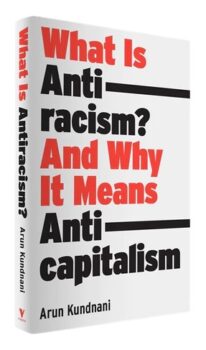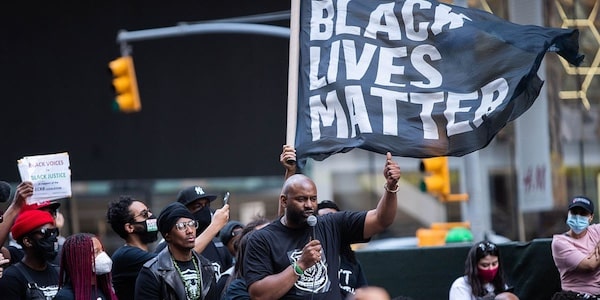
What Is Anti-racism? And Why It Means Anti-capitalism. Arun Kudnani, Verso (2023)
Previously the preserve of grassroots campaigns, anti-racist rhetoric has recently been taken up widely by the likes of BlackRock, Walmart, the UK Home Office and the U.S. State Department. This sounds like great news, except that it seems to go hand in hand with states continuing to bolster militaries, borders and mass incarceration, while economic dispossession disproportionately affects global racialised and marginalised populations.
Conservatives denounce racist attitudes while waging war on what they portray as elitist and unnecessary ‘woke’ politics, dismissing any talk of ‘structural racism’ and vilifying critical race theories that point it out. The anti-racist campaign is everywhere, yet structural racism thrives, almost unnoticed in liberal anti-racist discourse.
Writer and activist Arun Kundnani addresses this paradox in a cutting new book, in which he sets out the limits of liberal anti-racist approaches. With over three decades of activism and an impressive body of work to his name, Kundnani draws on a history of collective struggle to offer answers to how anti-racism can be rescued from corporate whitewashing to instead challenge the structures of ‘racial capitalism’.
Two types of anti-racism
What is often overlooked, Kundnani argues, is that there are two definitions at stake in contemporary debates: a liberal anti-racism and a more radical anti-racism. The former sees racism as a problem of irrational beliefs, prejudice, biases and hatred—a kind of extremism that threatens the normal functioning of liberal democracy.
He traces its roots to the campaigns of 1930s’ cultural thinkers such as anthropologist Ruth Benedict and gay rights activist Magnus Hirschfield, who were theorising the rise of Nazism in Germany and urged the U.S. political elite to educate the working class, believing that without this, economic hardship would make racism more likely. In this framework, education offers an antidote to racist social ills. The popularisation of U.S. author Robin DiAngelo’s book White Fragility is emblematic of this approach today, which focuses on the individual reform of white people and their unconscious biases as an end in itself.
To counter this, Kundnani draws upon a history of radical thought that explains what is ‘structural’ about ‘structural racism’, or what gives racism its power and endurance. In abolitionist thinker Ruth Wilson Gilmore’s terms, this means the uneven distribution of resources, and the vulnerability to structures of organised violence and premature death. Radical anti-racism has its roots in struggles against colonial power and emerged from those grappling with the role played by racism and imperialism in global systems of economic exploitation and oppression.
To set this out, Kundnani maps the political thought of a different set of key anti-imperialist and anti-racist organisers for whom ‘racism’ referred not to an individual’s mindset but to a central feature of capitalism. These thinkers, who include Claudia Jones, C L R James, Kwame Nkrumah and Franz Fanon, understood that racism was not just created to divide workers but to exploit them unequally. Claudia Jones showed this, for example in the ‘super exploitation’ of black women in the U.S. workforce, whereby race, like gender, allowed for lower wages and higher profits. Structural analyses such as these allowed also for connections to be drawn between the marginalised populations of Asia and Africa and those in the U.S. and Europe. Movements to dismantle structures of power had to address common concerns with a clear eye on the uneven exploitation inflicted by economic systems.
‘Racial capitalism’ supplies the instructive analytic framework to sum this up. The concept, as popularised by Cedric Robinson in Black Marxism (1983), refers to the way that race, as a construction, is an ‘organising’ feature of capitalism, allowing for exploitation of certain categories of workers—including the enslaved, indentured, colonised or migrant workers. Here, racial domination persists and renews itself specifically because of a state-sanctioned and continued investment in a capacity to partition populations in service of capitalist economy.
Neoliberalism’s racial regimes
What light can this framework shed on the role of race and class in today’s neoliberal system, and how well does this expose the limits of liberal anti-racism? Kundnani is convincing in his case that the neoliberal pretence that race and empire are unrelated to global capitalism is a fallacy: ‘Only in its own fantasies has neoliberalism produced a homogeneous market order.’
Rather, neoliberalism reinvented race and imperialism such that racism remains systemically ingrained in concerns over law and order, counter-narcotics, border protection and counter-terrorism. Neoliberal capital reservoirs are deeply embedded in international financial institutions, their systems of debt, economic restructuring, and labour, while its racisms are often disguised in a language of ‘cultural’ difference. Since the 1960s, the notion of culture and values, and the need to create appropriate conditions for capitalism became synonymous with openness to the neoliberal market.
What is particularly illuminating is Kundnani’s account of the role played by the ideological architects of neoliberal policy in the construction of immigration controls. Neoliberalisation policies of financial deregulation, ‘free trade’ and border controls were brought in by the west in response to growing social pressures from anti-colonial, labour and social movements in the 1960s and 70s. Thinkers such as Samuel P Huntington, Milton Friedman, Daniel Patrick Moynihan and Enoch Powell aimed to retain the west’s economic hegemony after decolonisation, and new systems of governance required new internal and external enemies, alongside distinctions between legitimate and superfluous labourers.
The power racism continues to hold is inextricable from the question of who, in the eyes of states, has the right to life, work, education, movement or healthcare and under what conditions, and who poses a threat to the status quo. It is also deeply intertwined with foreign policy, as Kundnani shows is the case with anti-Muslim racism, which gained traction in the context of the ‘war on terror’ and the occupation of Palestine. Given all this, ‘diversity’ approaches and liberal awareness training stand little chance of upending systematic racial injustices. Indeed, they become part of the problem.
What does radical anti-racism offer?
The clearest proof of this is that despite anti-racist campaigns, racist practices continue to be expanded and entrenched at the state level. The new UK immigration legislation passed in July, which gives unprecedented powers for the detention and deportation of ‘irregular’ migrants is just one example. Having more black and brown representation in popular culture or state institutions has not been shown to reduce racial discrimination. In fact, Kundnani argues, ‘liberal notions of diversity and inclusion were completely compatible with these forms of racist structural violence’.
Of course, this does not mean that racism in any form is excusable, or that racist attitudes should not be tackled. However, acknowledging root causes alters the way that the problem can be seen and acted upon. Where liberal anti-racism has been regarded as elitist or moralistic, radical anti-racism allows space for building collective power aimed at ending systemic exploitation across race and class divides.
Kundnani makes clear that abolition of certain words or personal attitudes does not abolish the structures that fuel them. This book is a call for a collective action and common futures through an ‘anti-racism that does not fragment class struggle but radicalises it’.
This article first appeared in Issue #241, Autumn 2023 Pan-Africanism.

